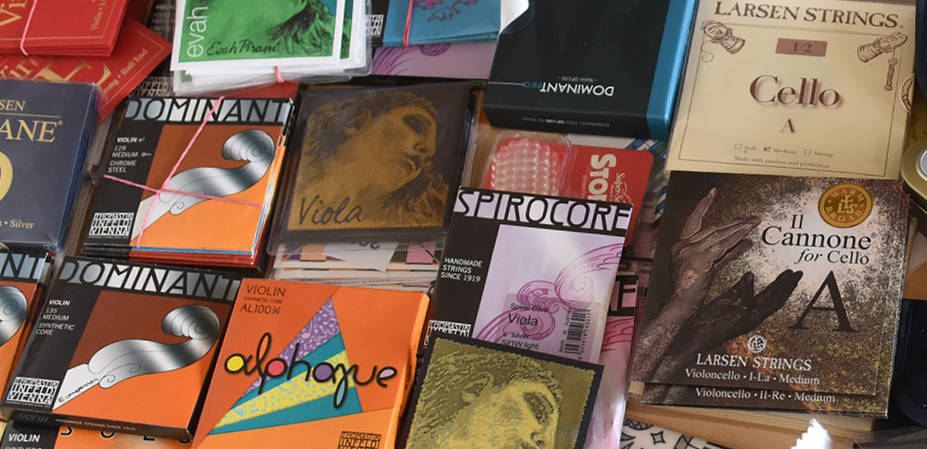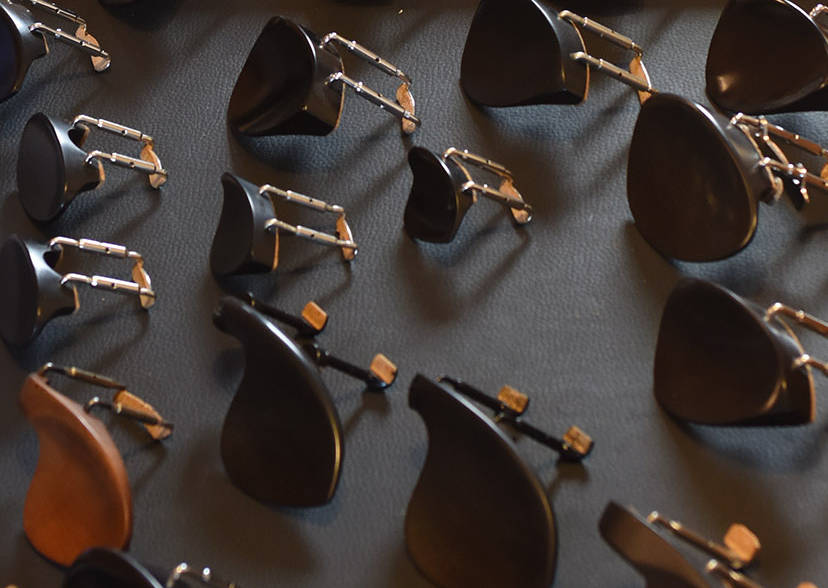Service
Accessories
Strings
Which strings do we recommend?

It depends…
If the bridge, soundpost, and fingerboard are in good condition, the question is whether you are basically satisfied with the sound. If you find that your instrument sounds too bright, then a warmer, softer string would be advisable. If it is too dark or dull for you, we might recommend a more brilliant, powerful set.
There is no such thing as THE set of strings, but certain sets of strings work well, each with its own tonal character.
Strings tend to break much less often today than in earlier times. Still, after a while they become worn out, and you barely notice the difference until you change them – and immediately realize that changing them earlier would have been helpful. Also, if the winding comes off, the string is no longer of any use and needs to be replaced.
Chinrests and shoulder rests
Playing a stringed instrument is a major challenge in terms of cognition and coordination.

In order for you to feel as relaxed as possible when you are practicing and performing, not only should your instrument setup be optimal, but the shoulder rest and chinrest must also fit very well – unless you have chosen the cello.
We always have a selection of shoulder rests in stock, along with a wide range of chinrests. Especially when it comes to chinrests, people unfortunately just tend to use the chinrest they purchased with the instrument. Poorly fitting chinrests, or chinrests with sharp edges or the wrong materials, can lead to painful skin inflammation (violin hickey). To avoid muscle tension and damage to the neck, it is important to find the right combination of chinrest and shoulder rest.
We will gladly help you with this.
Rosin
We always have some of our favorite rosins in stock.
Instrument cases
We also have instrument cases in stock for you.
Unfortunately, violin, viola and cello cases are not inexpensive if they are to be of good quality. A good hand-made case can accompany you for a lifetime.
The life span of simple cases is unfortunately quite short.
MISCELLANEA
Consultation
What is the goal of the repair? What is it going to cost? When would the instrument or bow be ready?
In conversation with you, we find out together what is necessary, feasible, and within your financial budget. If the repair fee exceeds the value of the instrument or bow, only you can decide whether its sentimental value is greater for you and the work should nevertheless be carried out.
You can only make a wise decision once you have been well advised.
How much does a violin cost?
We hear this question very often.
The answer is simple: “It depends…”. What are the buyer’s requirements and ambitions? Does someone want to start a professional career with it, or are they fulfilling a childhood dream in late years to make music for themselves or together with others? Is it a simple student instrument, or should it be a very good instrument? Should it be a good, simple student bow, or an old or new master bow? Instruments and bows are judged by their origin, age, quality of workmanship, and quality of wood.
Sound quality is something very subjective and is only included in the evaluation to a limited extent. Ideally, you have your financial limit in mind and test instruments and bows up to it – but without knowing the individual price. It does not always make sense to spend a lot of money. In certain cases, you might discover that you have a preference for an instrument that turns out to be less expensive. Sound and taste are subjective; they differ highly from one person to another, just as there is an immense variety of instruments. The challenge is to find the right instrument for you with the right price.
“But on the Internet I saw…”- yes, new factory violins or old instruments are sometimes cheaply on offer there. Often they are sold under false claims and rarely work as expected. You will probably find that you have to invest hundreds of euros after an online purchase just to get it to work reasonably well. Of course, real bargains are also possible – just like winning the jackpot.
Violin labels
It has become widely known:
The label inside a violin is often meaningless. “Stradivari” labels were often used in the past – not even to trick customers, just out of old tradition. Dealers and buyers knew that the student instrument was not a Stradivarius.
Over the decades, the grandfather joke “I’m going to practice on my Stradivarius now” fostered the eventual llusion that it might really be one. In the case of an inheritance, we are often obliged to disappoint: in the vast majority of cases, it will be a simple instrument. If you have questions about an instrument’s origin, it is always worth asking a luthier you trust.
Insurance
In Germany we tend to be over-insured.
If the possible loss or damage to the instrument does not entail a major financial challenge for you, you do not need to insure it. Still, in our workshop we often see major damages on instruments, and customers wish their instrument had been insured.
With major specialized insurers, expect to pay 1-1.5% of the instrument’s value per year plus insurance tax for a policy. Insurance may not ease the pain of a damaged, destroyed, or lost instrument or bow, but at least it ensures that there is no financial barrier to repair or replace it.
For rented instruments, you can check to see if your homeowner’s insurance automatically includes them, in which case it will pay.
The CITES document
What is a CITES document?
When you travel beyond the borders of the European Union with your instrument and bow, you need the so-called “Declaration of materials” for the border crossing, which explicitly lists which materials have been processed on the instrument and bow that are not covered by the Washington Convention on International Trade in Endangered Species of Wild Fauna and Flora (of course, it only makes sense to travel with instruments on which all materials are permitted, and then list them). This is to ensure that materials protected under the Convention on International Trade in Endangered Species of Wild Fauna and Flora are no longer being processed.
It is very obvious, for example, that today no ivory may be used in new bows. It also affects certain types of wood such as rosewood, as well as some types of leather. If you travel a lot and have never been asked for the “Declaration of materials”, you may simply have been lucky. Without the document, you risk confiscation of your instrument or bow.
Prior to your journey, choose your instrument and bow for which we can confirm with the “Declaration” that crossing the border is not a problem. Parts can be easily exchanged if necessary. Theoretically, you could cross EU borders with an old bow and ivory frog if it could be proven beyond doubt that the bow was built before 1947. That, however, requires an immense bureaucratic effort, and you have to show the bow at each border and discuss with the officials.
We thus advise that you only travel with instruments and bows for which you can be certain that there won’t be any problems.
Learning to become a violin maker
How do you find out if violin making would be the right career choice?
If you feel the desire to learn the violin making craft, you should entertain the idea of training at a violin making school. Finding an apprenticeship at a company is almost impossible. It is also only worthwhile if the workshop and its owner are actually willing to pass on extensive knowledge. A good violin making school is often the better choice (but not always …).
How do you find out if violin making would be the right career choice for you? It cannot be achieved without an internship, but they are very difficult to organize. You have to imagine that you would be doing your internship in a workshop where there is a master craftsman / master craftswoman and possibly also an employee. You yourself require close supervision and cannot contribute to the firm’s economic success (yet). While the violin maker is teaching you within regular working hours, he/she cannot earn anything. Lack of space is likewise often a problem. Be sympathetic, try to understand; remain friendly, yet persistent.
Just visit violin makers here and there and talk to them. Not all of them are always welcoming and helpful, because they are under a deluge of requests. Do not be deterred. If you really want to take up the profession, you will achieve your goal. We ourselves are happy that we have made it – to the point of self-employment. So we can’t advise against it, but it is a rocky road into a profession that is not highly paid.
We will be happy to make an appointment with you.
Tel.: 0049 3643 45 74 377 | Contact
